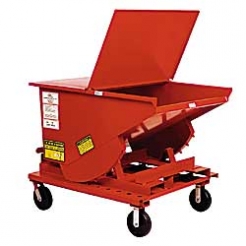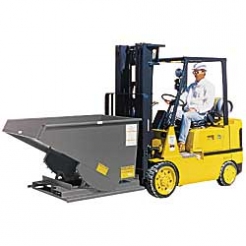 Self-dumping hoppers may be low-tech, gravity-activated tools, but they offer a highly effective way to load, transport and dump bulk and waste products safely and conveniently.
Self-dumping hoppers may be low-tech, gravity-activated tools, but they offer a highly effective way to load, transport and dump bulk and waste products safely and conveniently.
Self-dumping hoppers typically attach to the forks of a lift truck, powered pallet lifter, or even onto casters. Others are designed to sit permanently on top of dumpsters, storage containers, or other locations.
Mobile vs Stationary
When attached to a vehicle, the enclosed hopper that can be moved throughout a warehouse, manufacturing facility, or other workspace and filled with bulk materials, scrap, trash, or other items.
Once it is filled, the self-dumping hopper can be moved to a dumpster, storage bin, or other location. The operator can then push a mechanical switch that opens an oversized latch on the bottom of the hopper, allowing gravity to cause the materials within the hopper to fall into the desired location.
Once the hopper empties itself, springs attached to the bottom door pull it firmly back into place and the hopper self-locks. It can then be refilled.
Variety of Applications
Self-dumping hoppers are frequently used in recycling, construction, materials handling, manufacturing, and storage industries. They come in a variety of different sizes, ranging from 1,000 lb. to more than 6,000 lb. capacities. They also come in many different styles and with different features, including specialty lids that allow users to hide debris from the view of customers.
One of the biggest benefits of self-dumping hoppers is safety. Because they are simple to load and essentially empty themselves, there is a much lower risk of employees being injured by the handling of bulk items, debris and waste products. These helpful tools allow workers to handle potentially dangerous items hands-free.
Any building site generates a lot of debris, including wood and metal scraps, copper plumbing tubes, drywall, nails, roofing materials, and more. With self-dumping hoppers, these materials can be conveniently collected in one place, reducing the risk of workplace accidents and keeping construction zones clear of debris and other hazards.
In industrial settings, self-dumping hoppers are often fitted with feeding devices that can be attached to production lines and other equipment, making it easy to collect and remove waste materials safely.
Office Recycling
One of the fastest-growing uses of self-dumping hoppers is in office buildings, where they are frequently used to collect paper, cardboard and other recyclables.
Once these recycle bins are full, they can be wheeled to recycling collection area, where they can be simply and conveniently emptied before being returned to their recycling station.
Self-dumping hoppers may be one of the simplest tools, but they are also one of the most helpful in improving efficiency, safety, and profits.

